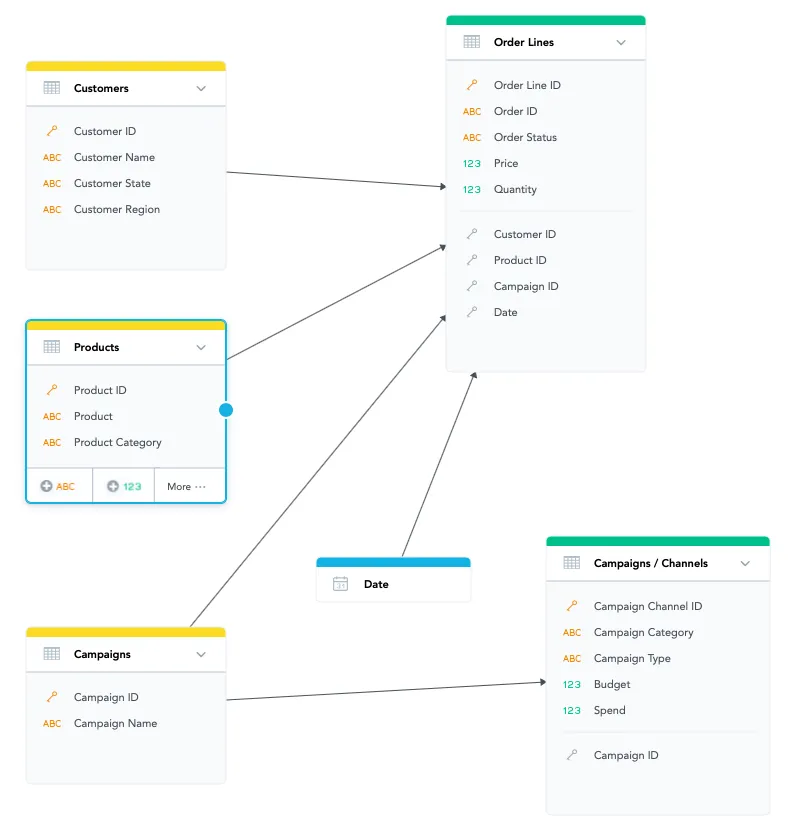
Dataset
A dataset is a logical object that represents a set of related facts, attributes, and attribute labels.
Datasets are basic organization units of a logical data model (LDM).
You can look at a dataset as a representation of a database table with its primary key and foreign key. A dataset’s primary key (so-called “grain”) defines the cardinality of the dataset. The primary key must be defined via either an attribute or a referenced dataset.
Facts, attributes, and attribute labels related to a particular dataset are automatically tagged with a tag object set to the identifier of the dataset.
Relationships between Datasets
Datasets are associated with each other through relationships. A relationship is a one-directional mapping between two datasets through a single primary key. The primary key functions like a database primary key. It identifies the field in the originating dataset that contains information to uniquely identify the data in other fields in the dataset.
When a relationship is created between two datasets, a foreign key field is inserted into the target dataset. This foreign key is populated by references to the primary key values in the dataset at the other end of the relationship.
The relationship is important because it determines what you slice by what when building your own metrics using MAQL - Analytical Query Language.
Example: Datasets in the LDM
- Fact datasets
Order Lines(primary keyOrder Line ID)Campaign / Channels(primary keyCampaign Channel ID)
- Attribute datasets
Customers(primary keyCustomer ID)Products(primary keyProduct ID)Campaigns(primary keyCampaign ID)
- Date datasets
Date
The direction of the arrow determines which dataset’s data can be analyzed (sliced) by the data from the other dataset. For example, in the LDM above, the relationship between the Customer and Order Lines datasets allows you to slice Quantity by Customer Name.
Date Datasets
A Date dataset is a dataset in the logical data model(LDM) that represents DATE / TIMESTAMP columns in your database. The Date dataset helps you manage time-based data and enables aggregation at the day, week, month, quarter, and year level.
When a relationship exists between a standard dataset and a Date dataset, the related foreign keys are mapped to the DATE / TIMESTAMP columns.
You can share a Date dataset with multiple standard datasets and then slice the facts from those standard datasets by the dates from the Date dataset.
You can create multiple Date datasets and create relationships between these Date datasets and one standard dataset, for example:
- Date datasets:
Created,Last Updated - Standard dataset:
Ticketscontaining two foreign keys,CreatedandLast Updated
A Date dataset in the LDM is identified by the following visual object:
Granularity Levels in a Date Dataset
GoodData supports only a subset of the granularity levels that GoodData.UI supports.
The Date datasets support the following categories of date/time granularity:
- Chronological
- Periodical
When used in the LDM, the Date dataset defines what levels of granularity can be used in your analytics and how the titles of the those levels should be presented.
| Category | Granularity | Identifier | Description |
|---|---|---|---|
| Chronological | Minute | minute | Date and time with minute granularity (for example, 2021-04-16 12:34) |
| Chronological | Hour | hour | Date and time with hour granularity (for example, 2021-04-16 12) |
| Chronological | Date | day | Date with day granularity (for example, 2021-04-16) |
| Chronological | Week/Year | week | Week and year (for example, 2021-20) |
| Chronological | Month/Year | month | Date with month granularity (for example, 2021-12) |
| Chronological | Quarter/Year | quarter | year |
| Chronological | Year | year | Date with year granularity (for example, 2021) |
| Periodical | Minute of Hour | minuteOfHour | Generic minute of the hour (1-60) |
| Periodical | Hour of Day | hourOfDay | Generic hour of the day (0-23) |
| Periodical | Day of Week | dayOfWeek | Generic day of the week (1-7) |
| Periodical | Day of Month | dayOfMonth | Generic day of the month (1-31) |
| Periodical | Day of Quarter | dayOfQuarter | Generic day of the quarter (1-92) |
| Periodical | Day of Year | dayOfYear | Generic day of the year (1-366) |
| Periodical | Week of Year | weekOfYear | Generic week (1-53) |
| Periodical | Month of Year | monthOfYear | Generic month (1-12) |
| Periodical | Quarter of Year | quarterOfYear | Generic quarter (1-4) |
Example:
To compute the revenue for the first day of a month, use the following metric:
select {metric/revenue} where {label/date.dayOfMonth}="01"The label identifier is
date.dayOfMonthwhere:
dateis the identifier of the dataset, anddayOfMonthis the identifier of the granularity.
